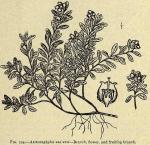 The dried leaves of Arctostaph'ylos u'va ur'si (Linné) Sprengel, with not more than 5 per cent. of stems or other foreign matter.
The dried leaves of Arctostaph'ylos u'va ur'si (Linné) Sprengel, with not more than 5 per cent. of stems or other foreign matter.
BOTANICAL CHARACTERISTICS.—Shrubs with trailing stems. Leaves alternate, coriaceous, evergreen, obovate or spatulate, entire. Flowers in terminal racemes, nearly white; corolla urn-shaped. Fruit a red drupe.
SOURCE.—In dry, sandy, or rocky soil from Hudson's Bay to New Jersey, in some parts of which it grows in abundance.
RELATED SPECIES.—Arctostaphylos glauca, indigenous to California (412).
DESCRIPTION OF DRUG.—Short-stalked, rather thick, coriaceous, obovate leaves, about 20 mm. (4/5 in.) in length, rounded at the apex and narrowed at the base; margin entire; surface smooth, glossy, grayish-green above, lighter colored and reticulated below; taste astringent, bitter; odor slight. (The powder has a hay-like odor.)
They are sometimes adulterated with the leaves of Vaccinium vitis ideae (European uva ursi), distinguished from the genuine by their rounder shape, their revolute margin, which is sometimes toothed, and the dotted appearance of their under surface. Chimaphila leaves, which are occasionally mixed with uva ursi, may be readily distinguished by their greater length, their cuneiform-lanceolate shape, and their serrate edges. Leiophyllum buxifolium(sand myrtle) and Epigaea repens (trailing arbutus, 415) are also used as adulterants.
Powder.—Characteristic elements: See Part iv, Chap. I, B.
CONSTITUENTS.—Tannic and gallic acids, and the three principles, arbutin, C12H16O7, ericolin, C34H56O21, and ursone, C10H16O7 which are common to the plants of the natural order Ericaceae. Arbutin is a bitter glucoside, occurring in colorless crystals; it is resolved by hydrolysis into glucose and hydroquinone or arctuvin, C6H6O. Ericolin is a yellow, crystalline, bitter glucoside. Ursone is in tasteless needles.
Preparation of Arbutin.—Precipitate decoction with lead acetate; filter; add H2S evaporate; evaporate slowly, when needles crystallize out. Dilute Fe2Cl6 gives blue color. Dose: 5 to 1.5 gr. (0.3 to 1 Gm.).
Preparation of Ursone.—Obtained by exhausting drug with ether. The alcoholic solution of the ethereal residue yields the crystals on slow evaporation. Occurs in tasteless needles; sparingly soluble in alcohol and ether. Insoluble in water.
ACTION AND USES.—Astringent, tonic, and diuretic; valuable in ulcerations of the kidneys, bladder, or urinary passages. It has been recommended in cystitis, its action being due to the decomposition of arbutin in the system and the excretion of the hydroquinone, which is a powerful disinfectant and antiferment. Dose: 15 to 60 gr. (1 to 4 Gm.).
- OFFICIAL PREPARATION.
- Fluidextractum Uvae Ursi Dose: 15 to 60 drops (1 to 4 mils).
412. ARCTOSTAPHYLOS GLAUCA Lindley.—MANZANITO. This is a small California evergreen tree or shrub whose leaves are there highly esteemed as an astringent, like uva ursi.

